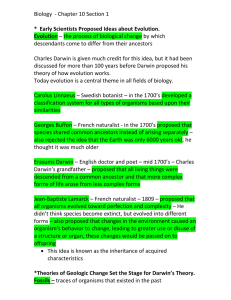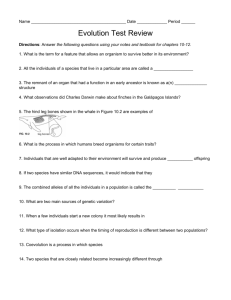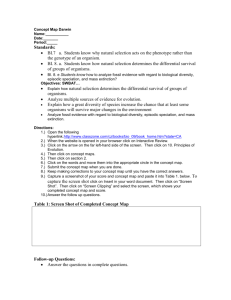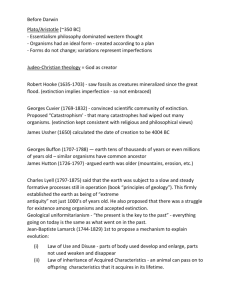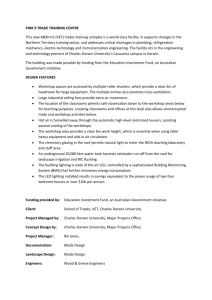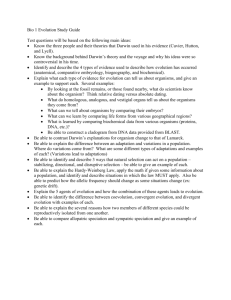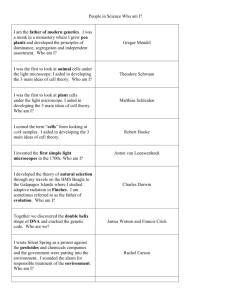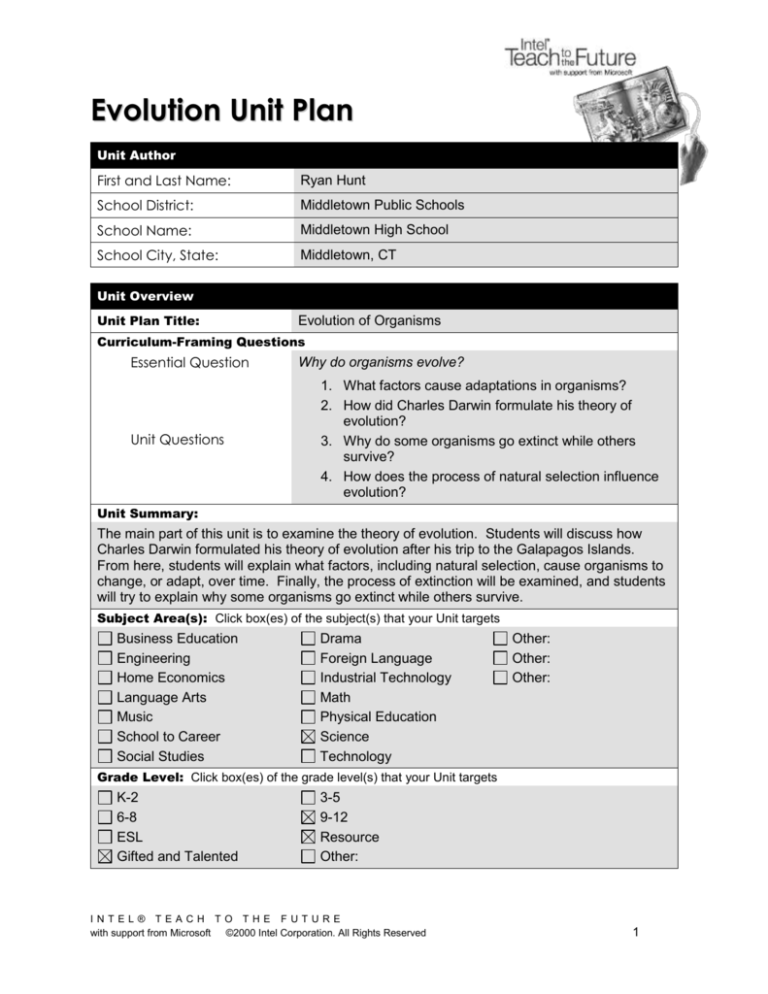
Evolution Unit Plan
Unit Author
First and Last Name:
Ryan Hunt
School District:
Middletown Public Schools
School Name:
Middletown High School
School City, State:
Middletown, CT
Unit Overview
Unit Plan Title:
Evolution of Organisms
Curriculum-Framing Questions
Essential Question
Unit Questions
Why do organisms evolve?
1. What factors cause adaptations in organisms?
2. How did Charles Darwin formulate his theory of
evolution?
3. Why do some organisms go extinct while others
survive?
4. How does the process of natural selection influence
evolution?
Unit Summary:
The main part of this unit is to examine the theory of evolution. Students will discuss how
Charles Darwin formulated his theory of evolution after his trip to the Galapagos Islands.
From here, students will explain what factors, including natural selection, cause organisms to
change, or adapt, over time. Finally, the process of extinction will be examined, and students
will try to explain why some organisms go extinct while others survive.
Subject Area(s): Click box(es) of the subject(s) that your Unit targets
Business Education
Engineering
Home Economics
Language Arts
Music
School to Career
Social Studies
Drama
Foreign Language
Industrial Technology
Math
Physical Education
Science
Technology
Other:
Other:
Other:
Grade Level: Click box(es) of the grade level(s) that your Unit targets
K-2
6-8
ESL
Gifted and Talented
3-5
9-12
Resource
Other:
INTEL® TEACH TO THE FUTURE
with support from Microsoft ©2000 Intel Corporation. All Rights Reserved
1
Targeted State Frameworks/Content Standards/Benchmarks:
CT Content Standard 5: Relationships of Structure and Function
1. Understand that the present diversity of life is a result of natural selection and other
evolutionary processes that have been at work for long periods of time.
2. Describe why diversity in a species is important for its survival in a changing
environment.
Student Objectives/Learning Outcomes:
1.
2.
3.
4.
5.
Create a timeline showing the order in which life evolved on Earth.
Explain how Charles Darwin came up with the theory of evolution.
Explain the factors that require an organism to adaptation.
Create an imaginary scenario in which one organism goes extinct and one survives.
Identify three examples of vestigial organs/structures.
Procedures:
The unit will begin with an examination of the evidence behind evolution, particularly
adaptations. On the second day, Charles Darwin and his voyage to the Galapagos Islands
will be discussed, and the students will take perform an internet scavenger hunt that will
recreate Darwin’s experiences. Over the third and fourth days, natural selection will be the
main focus. A power point demonstration will be used to deliver the notes to the students and
a “Survivor” type game will demonstrate how natural selection works. The fifth day will have
students doing a creative writing assignment in class, using their knowledge of natural
selection to explain a fictional species’ formation. Day six will have the students examining
biochemical evidence for evolution as well as pondering bacterial evolution. Days seven
through nine will have the students researching “living fossils” and creating a newsletter or
brochure to explain their findings. Finally, days ten through twelve, the students will create a
time line of the Earth’s major evolutionary events as either a power point presentation or a
web site.
Approximate Time Needed:
Twelve 45-minute class periods.
Prerequisite Skills:
Students should have prior knowledge of classification
Materials and Resources Required For Unit
Technology – Hardware: (Click boxes of all equipment needed)
Camera
Laser Disk
Computer(s)
Printer
Digital Camera
Projection System
DVD Player
Scanner
Internet Connection
Television
VCR
Video Camera
Video Conferencing Equip.
Other:
Technology – Software: (Click boxes of all software needed.)
INTEL® TEACH TO THE FUTURE
with support from Microsoft ©2000 Intel Corporation. All Rights Reserved
2
Database/Spreadsheet
Desktop Publishing
E-mail Software
Encyclopedia on CD-ROM
Printed Materials:
Supplies:
Image Processing
Internet Web Browser
Multimedia
Web Page Development
Word Processing
Other:
Daniel, L., Hummer, Jr., P. J., and Kaskel, A. (1999). Biology:
An Everyday Experience. Westerville, OH:
Glencoe/McGraw-Hill.
Microsoft Corporation. 2002. In Microsoft Encarta
Encyclopedia 2002 [CD-ROM]. Bloomsbury Publishing
Plc.
None.
Internet Resources:
http://www.glenn.morton.btinternet.co.uk/transit.htm
http://www.google.com
http://www.pbs.org/wgbh/nova/crocs/dinosaurs/dinosaurs2.html
Others:
None.
Accommodations for Differentiated Instruction
Resource Student:
Resource students will be able to do most activities without
extra time or assistance. For the two projects, students will be
given a storyboard for the power point presentation, newsletter,
and/or web site, and will be allowed extra time, if needed.
Non-Native English
Speaker:
Non-native English speaking students will be allowed time
outside of class to work with their ESL teachers on this
assignment. If alternate language web sites dealing with the
material can be found, they will be encouraged to use them.
Gifted Student:
Gifted students will be encouraged to add more events to their
power point presentations and find three theories to their
organism’s survival for the web site/newsletter.
Student Assessment:
Grades for the assessments will be based upon observation of
work habits, and the final products of the power point
presentation and newsletter / web site.
Key Word Search:
Evolution, adaptation, Charles Darwin, extinction, natural
selection, fossil, species.
Page 3 of 3

